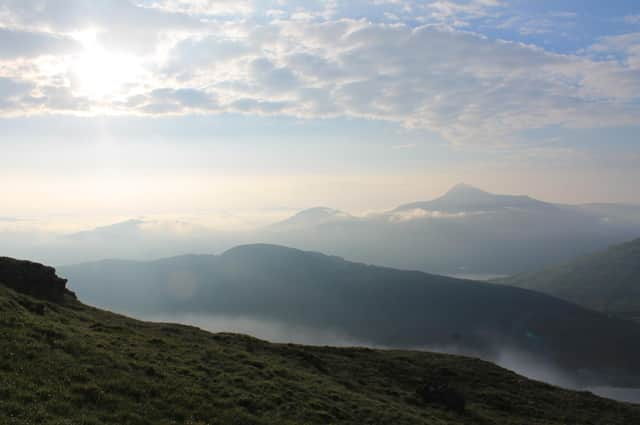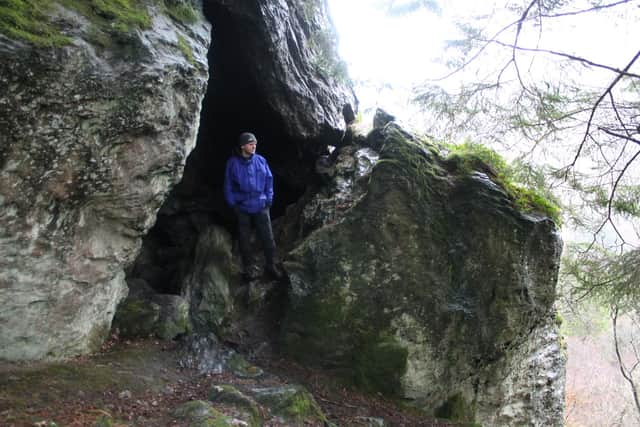Finding the secret caves that became the holy grail for hardcore climbers


The Glen Loin caves in the Arrochar Alps have for decades been the holy grail for climbers navigating the mountains in this part of the world.
Directions are often passed on in secret – and to publish the exact location frowned upon in case the thrill of the adventure is eroded away.
Advertisement
Hide AdAdvertisement
Hide AdIt is said the caves became the resting place for Robert the Bruce and his army following his defeat at Methven in 1306.


From the mid-20th Century they became the base for a new “makeshift society” of climbers who broke new ground in the hills and redefined the sport forevermore, said adventure writer Patrick Baker.
Baker visited the Glen Loin Caves for his new book The Unremembered Places, Exploring Scotland’s Wild Histories, which takes the reader on a fascinating trail through the folklore and stories behind some of the country’s more obscure locations.
He found directions to the caves online and took two months to decode the vague pointers left, he said,
“The directions are too vague, too inscrutable for precise placement. But maybe that is the point. They are deliberately unequivocal, to deter the undetermined, maintain the elusiveness of the place,” he wrote.
Baker said he had long held the caves in his imagination, given the “slow-drip of rumour and folklore” which underpin the shelter hidden beneath a colossal boulder field.
“Most people will never have heard of them but I have come to thing of them in near mythical terms,” he added.
He described the caves as a "focal point of a unique sporting counterculture” that became the almost permanent weekend residence for climbers, with clubs such as The Ptarmigan Club and the Creagh Dhu forged here.
Advertisement
Hide AdAdvertisement
Hide AdHe said: “It was here for almost two decades from the 1920s that groups of working class young people, mainly from the poverty-stricken tenements of Glasgow and shipyards of Clydebank, congregated to climb the huge rock walls of the Arrochar Alps.
“They created an almost permanent weeked residence in the caves. Small groups arrived at first, each with its own particular rules and hierarchies, then more established affiliations evolved.
“They redefined the sport, dismantling existing class barriers and creating a makeshift society in the Glen Loin Caves whose values and ethics became imprinted on generations of climbers that were to follow.
“Yet the caves and their whereabouts have managed to remain largely unknown for decades. Hidden partly by the obscurity of the landscape, but also by an unwritten code of fraternal discretions.”
In Unremembered Places, Baker tells of an account of the caves by outdoor writer Alistair Borthwick, who described the atmostphere of a night at Glen Loin in his 1939 book Always a Little Further.
Borthwick wrote of “always someone arriving”, adding: “As the shouting grew, others arrived. We had 18 in residence in the end...then they told stories...they seemed to have been in every conceivable variety of scrape on every conceivable variety of mountain, and the bigger the scrape, the louder the laughter.”
Borthwick said he first found the caves by the smell of woodsmoke and then the aroma of kippers rising into the air. He dropped down a hole into the cavern where each new person would drop their offering of sausages and eggs into a communal frying pan. Fires would sometimes be lit at the mouth of the main cave.
Cowboy songs and bothy ballads would be sung into the night and, in the early dawn, Borthwick wrote of poking his head up through the cave entrance to see over Long Long and Arrochar as the moon slipped behind the mountains
Advertisement
Hide AdAdvertisement
Hide Ad“I knew the satisfaction of being independent of any mechanical thing,” Borthwick wrote.
For Baker too, finally spending the night at the caves is pressed well into memory.
“It’s laughable, but I’m ridiculously pleased to have found the cave, finally closing a loop of such long-standing fascination,” he said.
---The Unremembered Places, Exploring Scotland’s Wild Histories, by Patrick Baker is published by Birlinn and available now priced £14.99.
A message from the Editor:Thank you for reading this story on our website. While I have your attention, I also have an important request to make of you.With the coronavirus lockdown having a major impact on many of our advertisers - and consequently the revenue we receive - we are more reliant than ever on you taking out a digital subscription.Subscribe to scotsman.com and enjoy unlimited access to Scottish news and information online and on our app. With a digital subscription, you can read more than 5 articles, see fewer ads, enjoy faster load times, and get access to exclusive newsletters and content. Visit https://www.scotsman.com/subscriptions now to sign up.
Our journalism costs money and we rely on advertising, print and digital revenues to help to support them. By supporting us, we are able to support you in providing trusted, fact-checked content for this website.
Joy Yates
Editorial Director
---------------------------------